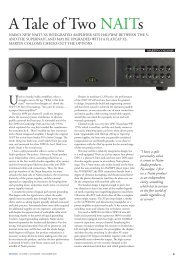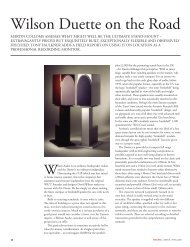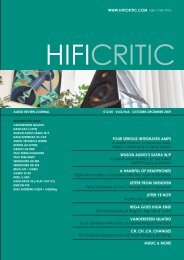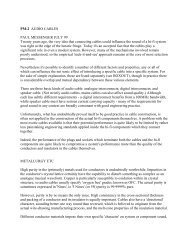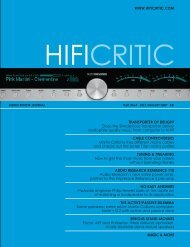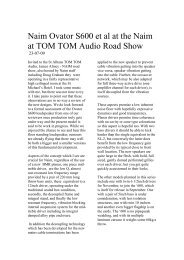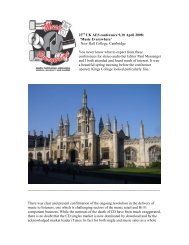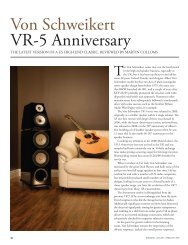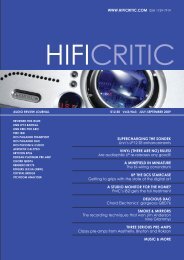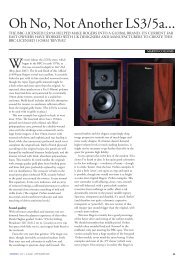The Unseen Variable - Hificritic.com
The Unseen Variable - Hificritic.com
The Unseen Variable - Hificritic.com
Create successful ePaper yourself
Turn your PDF publications into a flip-book with our unique Google optimized e-Paper software.
Perceptible shifts in tonality were apparent-there<br />
seemed to be more presence and edge definition,<br />
yet these were achieved without hardness or<br />
glare. <strong>The</strong> sound appeared to have opened out<br />
somewhat. And, again, a feeling of enhanced<br />
focus was heard in the midrange, though the<br />
impression of depth was now thought to be<br />
impaired.<br />
Remember that the <strong>com</strong>plexity of the human<br />
hearing process will mean that some of these<br />
observed effects result from subtle loudness<br />
changes alone. For example, one effect of a<br />
slight drop in level is to increase the sense of<br />
distance from the perceived soundsources.<br />
For the next set of <strong>com</strong>parisons, the replay level<br />
with the series resistor was increased by 2.5dB<br />
to restore the subjective impact and loudness of<br />
the program material. Now those previously<br />
misleading interpretations of fidelity caused by<br />
level reductions in certain frequency regions<br />
were blown away. This speaker, with its<br />
relatively neutral balance, was recognized as<br />
showing clear signs of a warped personality with<br />
the series resistor!<br />
<strong>The</strong> Tempo sounded less neutral with the series<br />
resistor. Its vocal balance, for example, was<br />
lightened and higher pitched. Cellos were<br />
emasculated, sounding more like violas than<br />
cellos, while the treble was projected. This can<br />
be attractive on some dull-sounding material, but<br />
causes undesirable emphasis on others. <strong>The</strong><br />
Tempo's bass was now unquestionably inferior<br />
to that with normal drive. Less even and wellcontrolled,<br />
the low frequencies were less a part<br />
of the whole sound. By whatever psychoacoustic<br />
association was at work, the bass appeared to<br />
lose drive and impact, percussive power and<br />
rhythm.<br />
On the plus side, gains were perceived in the<br />
midrange focus, depth, and perspective-these are<br />
the sorts of changes a speaker designer can<br />
introduce by judicious control of frequency<br />
response within a specified tolerance (see the<br />
sidebar). Often a price has to be paid for such<br />
indiscretions, different kinds of music revealing<br />
them as false tonal emphases or colorations.<br />
Comment<br />
<strong>The</strong>se anecdotal tests only go to show the<br />
remarkable <strong>com</strong>plexity of sound-quality changes<br />
that can result from using an amplifier with a<br />
significant source impedance. Even experienced<br />
critics-sorry, I do place myself in this categoryfind<br />
it very difficult, if not impossible, to<br />
separate these physical and acoustic interactions<br />
from the overall perception of sound quality. We<br />
have to accept that moderate tone-control<br />
effects-unfamiliar response changes over limited<br />
sections of the overall frequency range, allied to<br />
changes in level-can significantly alter perceived<br />
sound quality in all its many aspects. And, in my<br />
view, it isn't possible with any confidence to<br />
separate the sound of an amplifier from the<br />
changes it may impart to the frequency response<br />
and bass damping of a specific loudspeaker.<br />
A tubed SE amplifier may be of very high<br />
intrinsic quality, but its sound will always be<br />
hard to pin down, due to this unavoidable load<br />
interaction. <strong>The</strong> one exception will be with<br />
loudspeakers that have flat impedance<br />
characteristics. However, as such speakers tend<br />
to be 4 ohm designs, there will be an undue loss<br />
of overall power when they are driven by singleended<br />
tube amplifiers-something that is hard to<br />
accept given the limited power delivery<br />
available from such amplifiers.<br />
Evaluations of SE amplifiers tend, therefore, to<br />
degenerate into a search for that one special<br />
speaker-generally an off-the-beaten-track<br />
design-that has exactly the right response and<br />
impedance characteristics that its sound will be<br />
optimized when driven by an SE amp. Thus, the<br />
critic is rewarded, his skill in "system matching"<br />
vindicated, and the SE amplifier transports him<br />
to audio heaven.<br />
A case history<br />
To close, I offer a real-life example of an<br />
experienced critic who got the right musical<br />
result with an SE amplifier for the wrong<br />
reasons, and in the process unknowingly<br />
corrected a speaker problem.<br />
My colleague Ken Kessler and I recently cowrote<br />
a review of the Wilson WATT/Puppy V<br />
speaker system for the English magazine Hi-Fi<br />
News & Record Review ( HFN/RR, January<br />
1995, p.28.). We ran into some trouble in our<br />
assessment of the speaker. <strong>The</strong> test samples had<br />
been drawn from early production, which had<br />
generally been well-received by customers in the<br />
US.




